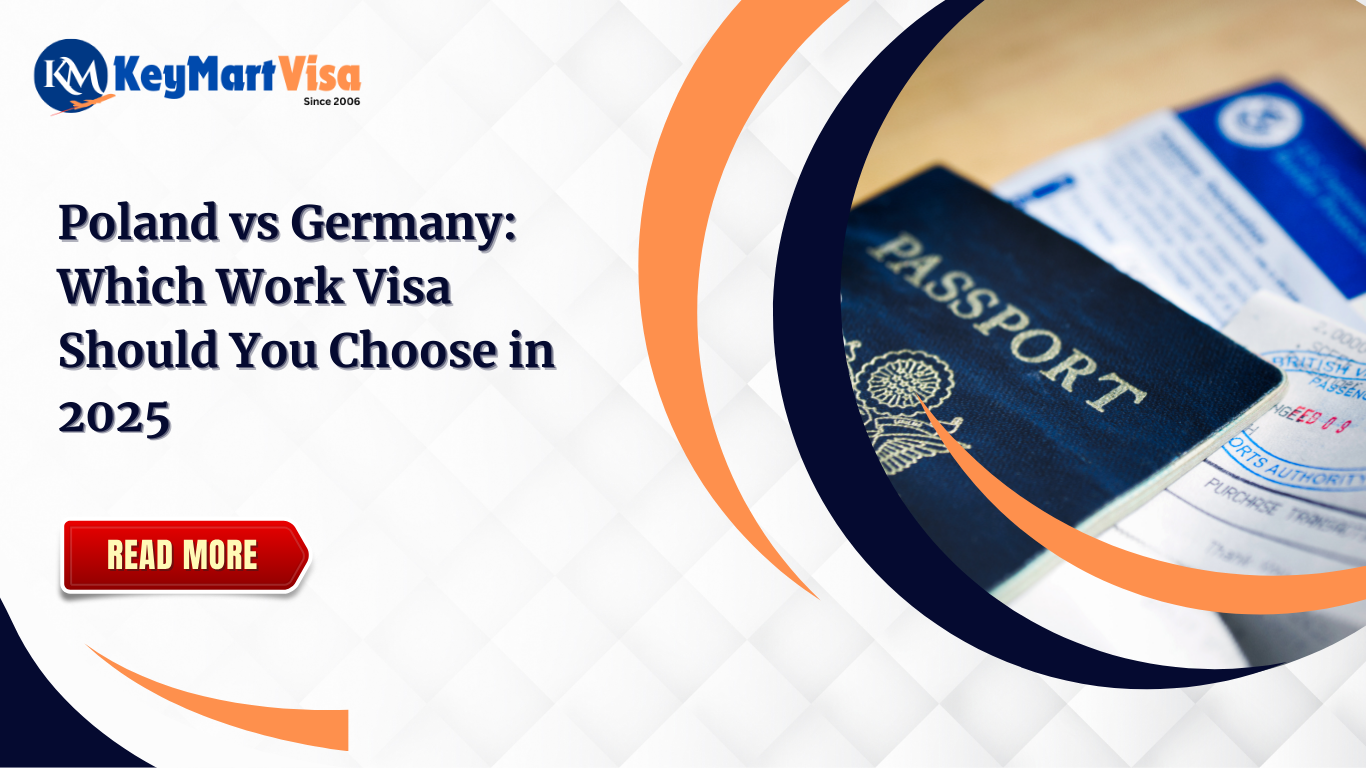Do you know that since 2019, over 4,60,000 skilled professionals from India have migrated to Europe by getting a Work Visa? This number is skyrocketing in the post-COVID-19 pandemic era, with the reasons including better career opportunities, a high standard of living, competitive salary packages, and more.
In recent years, Poland and Germany have become the primary destinations for candidates seeking to migrate. Both countries excel in their own areas, but selecting one over the other based on your skills and qualifications can be challenging, as various factors influence this decision.
In this article, we will provide a detailed guide on which work visa can be the best option for you. However, before proceeding, let us give a brief overview of the work visa.
Work Visa – A Pathway to Global Opportunities
A Work Visa is a unique legal document typically issued by the Government of a foreign country or the Immigration Department to a non-citizen of that country, allowing them to work in the country legally for a specified duration.
This document serves as a legal authorization for a non-citizen to explore career opportunities there, subject to specific terms and conditions. These terms and conditions vary country by country.
The Work Permit also stimulates global talent mobility for businesses that require those skills.
Germany: Work Visa Options Availability
Germany has been one of the strongest economies in Europe, and we know that a growing and robust economy demands more skilled professionals from various sectors, including IT, Healthcare, and Services, to maintain its position. Therefore, Germany offers multiple work visa options to attract qualified professionals.
German EU Blue Card
The German EU Blue Card is a unique type of residence and work permit designed for highly skilled non-EU professionals. This visa option requires candidates to hold a recognised university degree and a job offer in Germany with a minimum annual salary of EUR 48,300 (gross) in 2025.
To apply for this program, candidates must understand the application process, schedule an interview with the German embassy or consulate in their home country (VFS Global in India) for document and biometric submission, and then submit their application for this visa program.
Germany Opportunity Card
The Germany Opportunity Card is another unique visa program designed to attract skilled professionals from non-EU nations. This visa program has replaced the Job Seeker Visa, which was previously granted for only 6 months. Now, with this visa program, candidates with a Germany Opportunity Card Visa can stay and explore better career opportunities in Germany for upto 1 year.
To apply for this visa program, a candidate atleast have at least two years of vocational training or a university degree, which should be recognised in their home country.
Additionally, the candidate is required to demonstrate A1 level proficiency in the German language and B2 level proficiency in the English Language, and must obtain at least 6 points, which is based on various factors: age, Language Proficiency, Educational Qualification, and other related factors.
Poland: Work Visa Options Availability
Poland is another of the fastest-growing economies in Europe, which demands more skilled and semi-skilled professionals. Additionally, approximately 40,000 skilled professionals are currently working in Poland, with the number increasing gradually.
To facilitate skilled migration in Poland, the Polish government offers different types of work visa options for qualified professionals from around the world, including some of the top and most popular work visa options for skilled professionals.
Type A Work Permit
The Type A work permit is made for foreign skilled professionals. This visa is granted to a qualified professional who is working for a registered Polish employer and is only valid for the specific employer and position mentioned in the permit. It works as a closed work permit.
Type B Work Visa
This Polish Work Visa is designed for skilled professionals working as board members (directors, executives, company members). This visa program is usually valid for upto 6 to 12 months.
Type C Work Permit
This work visa is designed for foreign skilled professionals who a foreign employer has employed has employed for more than 30 days in Poland. This visa program is most commonly used by the multinational companies sending their staff to Poland.
Type D Visa
The Type D visa is made for foreign nationals sent by foreign employers to work in Poland’s export services, when the foreign employers don’t hold a Polish branch.
Type E Visa
The Type E visa is issued to foreign nationals who have been assigned various work-related tasks that are not covered by either of the Type A, B, C, or D permits.
Poland vs Germany: Comparison Between Salary and Cost of Living
The salaries and cost of living in Poland and Germany exhibit significant differences; below, we provide an insight into these differences.
| Basis | Poland | Germany |
| Avg. Monthly Net Salary | ~$1,639 | ~$3,264 |
| Cost of Living (1 person) | ~$1,315 | ~$1,778 |
| Rent (1-person) | ~$757 | ~$937 |
| Food / Dining Out | $374 (groceries) | $561 |
| Public Transport | $64.5 | $128 |
Poland vs Germany: Which Country to Choose?
Selecting between Germany and Poland for your 2025 work visa largely depends on your career aspirations, qualifications, and lifestyle choices. Both nations have excellent opportunities, but they have varying salaries, visa systems, and living expenses.
Why Go to Germany?
- Better Pay: Salaries are almost double that of Poland (~$3,264 vs ~$1,639).
- More Visa Opportunities: EU Blue Card and Opportunity Card for Highly Qualified Professionals.
- Professional Growth: Good demand in IT, health care, and engineering with settling prospects in the long term.
- Global Reputation: German work experience is highly valued worldwide.
Suited best for experts with high qualifications (IT, health care, engineering, finance), meeting language and qualification requirements.
Why Poland?
The Cost of Living is Lower: accommodation, transport, and groceries are much cheaper than in Germany.
- Less Complex Entry Routes: Type A, B, C, D, and E work permits offer various routes for skilled and semi-skilled specialists.
- Growing Economy: Poland boasts one of Europe’s fastest-growing economies, characterized by expanding job opportunities and robust economic growth.
- Gateway to Europe: Starting in Poland can be a stepping stone to other EU countries.
Most suitable for semi-skilled and skilled laborers who can afford living, easier entry, and consistent career growth.
What’s Next?
If greater incomes, career advancement, and a long-term stay are your primary concerns, then Germany is the best choice.
If more affordability, easier visa access, and European experience are your concerns, Poland is the wiser choice.
Either path may lead to a career on the global stage; your choice is primarily a matter of your skills, financial goals, and immigration purposes.
If you need more details about the Poland or Germany Work Visa, contact Keymart Visa via +91 9911338722 or info@keymartvisa.com





